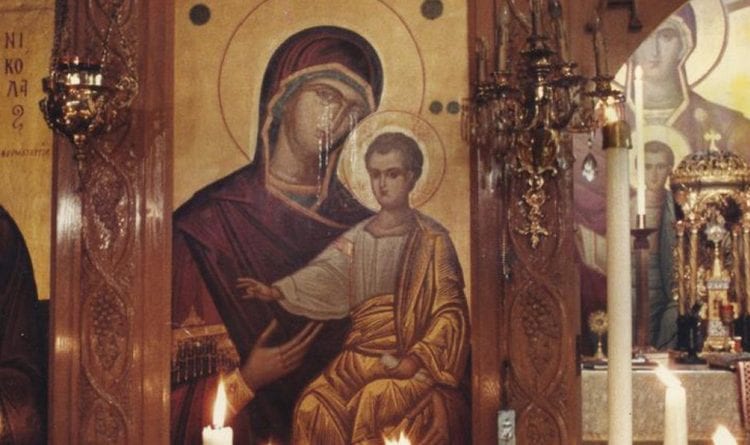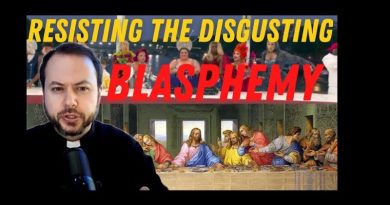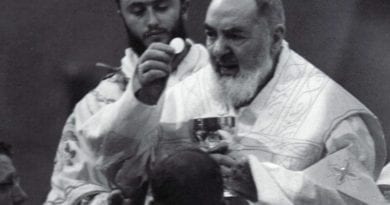Miraculous Icon in Illinois Still Weeping Oil After Two Years. Reports of Healings…Visitors Given Cotton Balls “Soaked in Oil” Upon Leaving
Follow Mystic Post on Facebook
Patti Maguire Armstrong OSV Newsweekly
The simple beige exterior of Assumption Greek Orthodox Church in Homer Glen, Illinois, was not what I expected as the home of a miraculous icon weeping oil since July 2015.
My friend and I checked the address carefully, because we had driven past it and were doubling back. “Is that it?” she wondered, pointing to the lowly brick building. “It doesn’t look like a church.”

More than a year later, however, on this July afternoon, only a handful of people were present. Visitation is limited to three hours on Thursdays and Saturdays.
Sacred space
Inside the church — furnished with chairs rather than pews — the surrounding gilded icons create a sacred space. Keeping with Eastern Orthodox tradition, there is an iconostasis — a wall between the body of the church and the sanctuary — filled with icons, eight in all. The door cut into the center of the wall leads to the altar. As is also customary, an icon of Jesus is to the right of the door, and next to him is St. John the Baptist. To the left of the door is the Theotokos — the Blessed Mother — always shown holding Christ, and to her left is an icon of the saint or event to which the church is dedicated.
We approached the icon of St. John the Baptist and saw oil streaming from wings, halo, hands, beard and feet into a reservoir at the bottom lined with a long swath of cotton. A short, stocky man, Louis Klioris, walked over and introduced himself as a friend of the pastor, Father Sotirios “Sam” Dimitriou. He offered to bless us with the oil. Using a thin paintbrush dipped into a glass of oil, Klioris made the sign of the cross on our foreheads, cheeks, chins and hands. A sweet, gentle fragrance emanated from the oil, believed to be myrrh. It would stay with us throughout the day until we reluctantly washed our hands and faces before bed that night.
As we gazed upon the icon, Klioris pointed to the one of Jesus. “Oil started coming from this one, too, about six weeks ago,” he said. We stepped in front of it and saw three trails of oil descending from the right hand.
Louis Klioris of Assumption Greek Orthodox Church in Homer Glen, Ill. Photo by Patti Maguire Armstrong
Why this church?
Father Dimitriou warmly welcomed us into his office at the back of the church to ask questions. He has been a priest for 25 years and is the father of two, ages 19 and 4 (Orthodox priests are allowed to marry).
The parish of 200 families formed in 1916 and has been at its current location for four years. When the oil first began, Father Dimitriou immediately called his bishop, who came to witness the weeping icon. “I’ve approached it as a blessing,” he said. “It’s not for myself or just the church or community, but it’s for everybody.”
Why his church? “You would expect this to happen at a big cathedral, not at a little church on Bell Road,” Father Dimitriou said. He does not claim to know the mind of God but said he sees similarities in the humility of St. John the Baptist and his simple church. “When you come in, it gives you a sense of a prayer and a warm feeling of solitude,” he said.
Father Dimitriou said there have been many reports of healings. He himself was healed from a nerve problem. Although he spoke freely, Father Dimitriou noted that he sees his role as welcoming people and sharing the blessing of the icon, not advertising its presence to the world.
A moving experience
John Ackerman, spokesman for the Greek Orthodox Metropolis of Chicago, acknowledged that, in fact, two icons were weeping oil. “They are not random pictures,” he said, “they are a vital part of every parish.” Another aspect, Ackerman pointed out, is that the entire iconostas of eight icons are made from the same materials but only two of them are weeping. “If there was a natural explanation, the same thing should happen on all the icons,” he said.
Weeping icons are unusual but not unheard of in the Orthodox Church, Ackerman explained. For instance, there are two icons of the Blessed Mother at St. George’s Orthodox Church in Taylor, Pennsylvania, reported to weep oil, and in the 1980s and ’90s, there were other reported weeping icons in the Chicago area.
“No one is trying to drive an interest in the weeping icons, and we don’t put a stamp of approval or disapproval on it,” Ackerman said. “We acknowledge what is happening and just let people witness it for themselves. It’s been a moving experience.”
The artist
The artist of the entire screen of icons, Peter Mihalopoulos, is a deacon and chanter at the parish. He has written icons for 45 years. Years ago, he made one of the Blessed Mother that dripped liquid from her hands.
“I feel very blessed that this is happening,” he said in a phone interview. “I can’t express the feeling; it’s overwhelming.”
Prayer and fasting are his life, Mihalopoulos said, because they are an important part of creating icons as well as studying the saints. “I’m glad God approves of my work, and I don’t care to have attention from people,” he said. “I only care that my name is written in heaven.” Mihalopoulos expressed concern that Roman Catholics don’t understand that Eastern Orthodox icons are “the art of art” that offer a glimpse into heaven.
Upon leaving Assumption Church, visitors are given cotton balls soaked in the oil and placed in a plastic bag to take home. No one asks for donations, although there is a small box for anyone who wishes to give. “What I ask for is prayers for our church,” Father Dimitriou told us. “It’s all about prayer.”The two churches split in 1054 over the primacy of the pope and other issues, reconciled periodically, then permanently split in 1450. The East kept the icons. Both share apostolic succession and valid sacraments. Since the 1960s, divisions have begun to heal, first evidenced by the meeting between Pope Blessed Paul VI and Ecumenical Patriarch Athenagoras in Jerusalem in 1964 and the mutual lifting of excommunication the following year.
Patti Maguire Armstrong writes from North Dakota.
Since you’re here …
… we have a small favor to ask. More people are reading Mystic Post than ever but advertising revenues across the media are falling fast. And unlike many news organisations, we haven’t put up a paywall – we want to keep our journalism as open as we can. So you can see why we need to ask for your help. Mystic Post’s independent journalism takes a lot of time, money and hard work to produce. But we do it because we believe our perspective matters – because it might well be your perspective, too.
High quality journalism is essential intellectual nourishment. The generosity of providing such a service without a paywall deserves recognition and supportGiacomo P, Italy
I’ve been enjoying Mystic Posts for several years now. Today, when so much seems to be going wrong in the world, Mystic Post is working hard to provide truthful Catholic news. I want to support that Robb R. UK
I appreciate there not being a paywall: it is more democratic for the media to be available for all and not a commodity to be purchased by a few. I’m happy to make a contribution so others with less means still have access to information. Annonymous Donator






